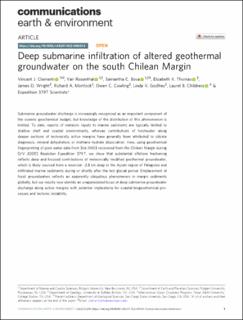| dc.contributor.author | Clementi, Vincent J. | |
| dc.contributor.author | Rosenthal, Yair | |
| dc.contributor.author | Bova, Samantha C. | |
| dc.contributor.author | Thomas, Elizabeth K. | |
| dc.contributor.author | Wright, James D. | |
| dc.contributor.author | Mortlock, Richard A. | |
| dc.contributor.author | Cowling, Owen C. | |
| dc.contributor.author | Godfrey, Linda V. | |
| dc.contributor.author | Childress, Laurel B. | |
| dc.contributor.author | Aiello, Ivano W. | |
| dc.contributor.author | Avila, Alejandro | |
| dc.contributor.author | Biggs, William | |
| dc.contributor.author | Charles, Christopher D. | |
| dc.contributor.author | Cheung, Anson H. | |
| dc.contributor.author | deLong, Kimberly | |
| dc.contributor.author | Dove, Isabel A. | |
| dc.contributor.author | Du, Xiaojing | |
| dc.contributor.author | Estes, Emily R. | |
| dc.contributor.author | Fuentes, Ursula | |
| dc.contributor.author | García-Lasanta, Cristina | |
| dc.contributor.author | Goldstein, Steven L. | |
| dc.contributor.author | Golub, Anna | |
| dc.contributor.author | Hagemann, Julia Rieke | |
| dc.contributor.author | Hatfield, Robert G. | |
| dc.contributor.author | Haynes, Laura L. | |
| dc.contributor.author | Hess, Anya V. | |
| dc.contributor.author | Irvali, Nil | |
| dc.contributor.author | Kiro, Yael | |
| dc.contributor.author | Monteagudo, Minda M. | |
| dc.contributor.author | Lambert, Jonathan E. | |
| dc.contributor.author | Li, Chen | |
| dc.contributor.author | Longo, William M. | |
| dc.contributor.author | McGrath, Sarah | |
| dc.contributor.author | Riechelson, Hailey | |
| dc.contributor.author | Robinson, Rebecca S. | |
| dc.contributor.author | Sarao, John | |
| dc.contributor.author | Sproson, Adam D. | |
| dc.contributor.author | Taylor, Shawn | |
| dc.contributor.author | Yokoyama, Yusuke | |
| dc.contributor.author | Yu, Siyao M. | |
| dc.date.accessioned | 2023-02-14T12:12:14Z | |
| dc.date.available | 2023-02-14T12:12:14Z | |
| dc.date.created | 2022-11-16T12:49:34Z | |
| dc.date.issued | 2022 | |
| dc.identifier.issn | 2662-4435 | |
| dc.identifier.uri | https://hdl.handle.net/11250/3050699 | |
| dc.description.abstract | Submarine groundwater discharge is increasingly recognized as an important component of the oceanic geochemical budget, but knowledge of the distribution of this phenomenon is limited. To date, reports of meteoric inputs to marine sediments are typically limited to shallow shelf and coastal environments, whereas contributions of freshwater along deeper sections of tectonically active margins have generally been attributed to silicate diagenesis, mineral dehydration, or methane hydrate dissociation. Here, using geochemical fingerprinting of pore water data from Site J1003 recovered from the Chilean Margin during D/V JOIDES Resolution Expedition 379 T, we show that substantial offshore freshening reflects deep and focused contributions of meteorically modified geothermal groundwater, which is likely sourced from a reservoir ~2.8 km deep in the Aysén region of Patagonia and infiltrated marine sediments during or shortly after the last glacial period. Emplacement of fossil groundwaters reflects an apparently ubiquitous phenomenon in margin sediments globally, but our results now identify an unappreciated locus of deep submarine groundwater discharge along active margins with potential implications for coastal biogeochemical processes and tectonic instability. | en_US |
| dc.language.iso | eng | en_US |
| dc.publisher | Nature | en_US |
| dc.rights | Navngivelse 4.0 Internasjonal | * |
| dc.rights.uri | http://creativecommons.org/licenses/by/4.0/deed.no | * |
| dc.title | Deep submarine infiltration of altered geothermal groundwater on the south Chilean Margin | en_US |
| dc.type | Journal article | en_US |
| dc.type | Peer reviewed | en_US |
| dc.description.version | publishedVersion | en_US |
| dc.rights.holder | Copyright 2022 The Author(s) | en_US |
| dc.source.articlenumber | 218 | en_US |
| cristin.ispublished | true | |
| cristin.fulltext | original | |
| cristin.qualitycode | 1 | |
| dc.identifier.doi | 10.1038/s43247-022-00541-3 | |
| dc.identifier.cristin | 2074831 | |
| dc.source.journal | Communications Earth & Environment | en_US |
| dc.identifier.citation | Communications Earth & Environment. 2022, 3, 218. | en_US |
| dc.source.volume | 3 | en_US |

